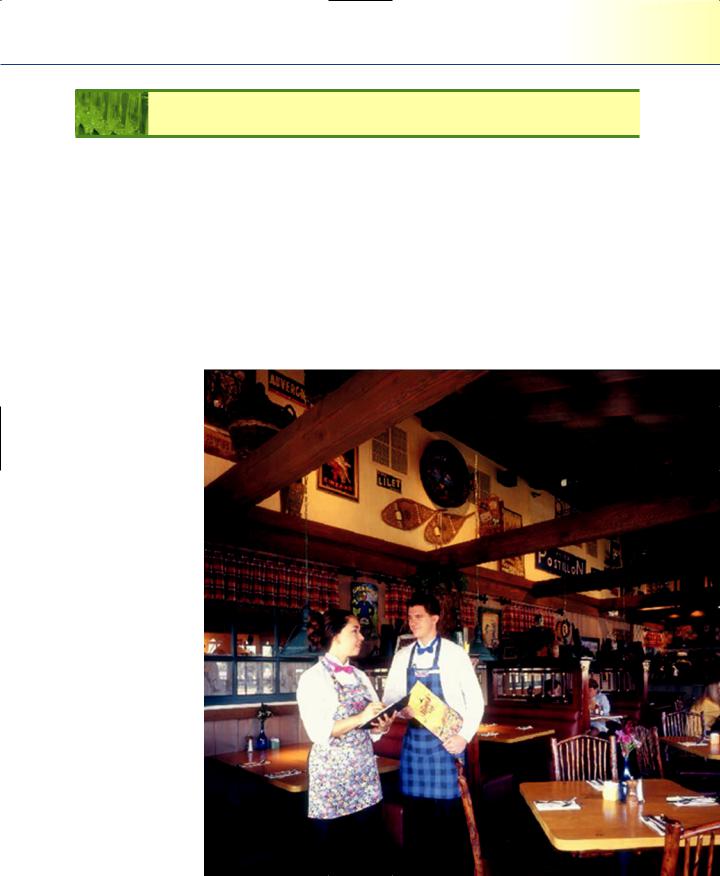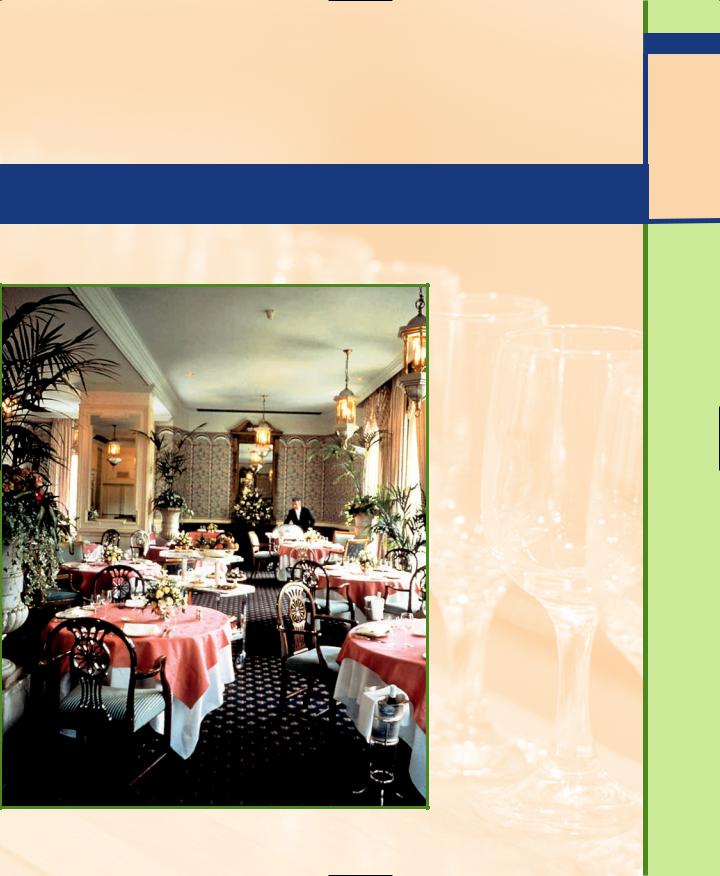
- •CONTENTS
- •PREFACE
- •Content—Benefits for Students
- •Content—Benefits for Instructors
- •Features of the Book for Students and Instructors
- •Supplementary Materials
- •Acknowledgments
- •What Is Hospitality Management?
- •The Manager’s Role in the Hospitality Industry
- •Why Study in a Hospitality Management Program?
- •Planning a Career
- •Employment as an Important Part of Your Education
- •Getting a Job
- •Employment at Graduation
- •The Outlook for Hospitality
- •Summary
- •Managing Change
- •Demand
- •Supply
- •Workforce Diversity
- •The Impact of Labor Scarcity
- •Summary
- •The Varied Field of Food Service
- •The Restaurant Business
- •The Dining Market and the Eating Market
- •Contemporary Popular-Priced Restaurants
- •Restaurants as Part of a Larger Business
- •Summary
- •Restaurant Operations
- •Making a Profit in Food Service Operations
- •Life in the Restaurant Business
- •Summary
- •Chain Restaurant Systems
- •Independent Restaurants
- •Franchised Restaurants
- •Summary
- •Competitive Conditions in Food Service
- •The Marketing Mix
- •Competition with Other Industries
- •Summary
- •Self-Operated Facilities
- •Managed-Services Companies
- •Business and Industry Food Service
- •College and University Food Service
- •Health Care Food Service
- •School and Community Food Service
- •Other Segments
- •Vending
- •Summary
- •Consumer Concerns
- •Food Service and the Environment
- •Technology
- •Summary
- •The Evolution of Lodging
- •Classifications of Hotel Properties
- •Types of Travelers
- •Anticipating Guest Needs in Providing Hospitality Service
- •Service, Service, Service
- •Summary
- •Major Functional Departments
- •The Rooms Side of the House
- •Hotel Food and Beverage Operations
- •Staff and Support Departments
- •Income and Expense Patterns and Control
- •Entry Ports and Careers
- •Summary
- •The Economics of the Hotel Business
- •Dimensions of the Hotel Investment Decision
- •Summary
- •The Conditions of Competition
- •The Marketing Mix in Lodging
- •Product in a Segmented Market
- •Price and Pricing Tactics
- •Place—and Places
- •Promotion: Marketing Communication
- •Summary
- •The Importance of Tourism
- •Travel Trends
- •The Economic Significance of Tourism
- •The United States as an International Tourist Attraction
- •Businesses Serving the Traveler
- •Noneconomic Effects of Tourism
- •Summary
- •Motives and Destinations
- •Mass-Market Tourism
- •Planned Play Environments
- •Casinos and Gaming
- •Urban Entertainment Centers
- •Temporary Attractions: Fairs and Festivals
- •Natural Environments
- •On a Lighter Note. . .
- •Summary
- •Management and Supervision
- •The Economizing Society
- •The Managerial Revolution
- •Management: A Dynamic Force in a Changing Industry
- •What Is Management?
- •Summary
- •Why Study Planning?
- •Planning in Organizations
- •Goal Setting
- •Planning in Operations
- •The Individual Worker as Planner
- •Long-Range Planning Tools
- •Summary
- •Authority: The Cement of Organizations
- •Departmentalization
- •Line and Staff
- •Issues in Organizing
- •Summary
- •Issues in Human-Resources Management
- •Fitting People to Jobs
- •Recruiting
- •Selection and Employment
- •Training
- •Retaining Employees
- •Staff Planning
- •Summary
- •The Importance of Control
- •Control and the “Cybernetic Loop”
- •Tools for Control
- •Summary
- •Leadership as Viewed by Social Scientists
- •Why People Follow
- •Leadership Theories
- •Communication
- •The Elements of Leading and Directing
- •Developing Your Own Leadership Style
- •Summary
- •A Study of Service
- •Rendering Personal Service
- •Managing the Service Transaction
- •How Companies Organize for Service
- •Summary
- •INDEX

Workforce Diversity |
53 |
occupations (those that are most directly competitive with hourly hospitality jobs) will grow at over twice the average rate, at 33.4 percent.18 As an industry, then, we can expect to face stiff competition for workers.
What means is the industry likely to use to fill these positions? Already in many markets, starting food service workers are receiving well above minimum wage. In some markets, employers are offering increased benefits, bonuses, transportation, and an assortment of offerings designed to encourage hourly employees to stay with their company.
Further, companies are target-marketing segments of potential employees such as seniors and other groups. Some operations, for instance, have held free breakfasts for seniors to get them interested in jobs. Marriott aggressively targets potential female employees. A Marriott representative stated that “One of the most difficult challenges in the 21st century is the scarcity of talent. . . . That makes female leadership a do or die business . . . you need to recruit and retain female talent as though your future depends on it—because it does.”19 Many other companies have also realized that it is prudent to take more of a marketing-oriented approach to attracting employees.
Another source of labor will be immigrants, both legal and illegal. The nonHispanic white labor force will grow by 12 percent between 2000 and 2010, but the number of Hispanic workers will increase about three times as fast, at 36.3 percent. The number of Asian workers will grow 44.1 percent in the same period.20
Illegal immigration is like floodwater around a dike—always there and always seeking entry through any hole in the structure. Repeated crackdowns, like temporary repairs to a dike, stanch the flow for a time. However, as long as the employment outlook in the United States is better and wages several times higher than in Latin America, it is likely that immigrants will continue to be an important source of labor in certain parts of North America.
Finally, part-time workers, who have always played a major role in food service, will continue to be important. Interestingly, approximately one-half of all food service employees work part-time. This is a far higher percentage of the working population than in the workforce, overall, which is 20 percent.21 The part-time labor pool is made of many people who have other claims on their time and need to supplement their income. This can make them an attractive source of labor.
Table 2.4 provides a visual description of the net impact that employment fluctuations can have on staffing requirements.
Workforce Diversity
The components of diversity include ethnic background and place of birth, education and skill level, income level, gender, age, differing abilities, and sexual orientation.
Organizations have generally tolerated diversity and tried to regulate it. With growing

54 |
Chapter 2 Forces Affecting Growth and Change in the Hospitality Industry |
 TABLE 2.4
TABLE 2.4 




























































Staffing Requirements—Chain Restaurants
Chain Restaurant Staffing Requirements
|
|
|
|
|
HOURLY |
|
MAN- |
EXISTING |
|
NO. OF |
|
|
NEW |
EMPLOYEES |
|
AGERS |
MANAGERS |
|
UNITS |
UNITS |
PERCENT |
PROMOTED |
|
HIRED |
MOVED TO |
|
|
BEGINNING |
MANAGERS |
TO ASST. |
DEPARTING |
FROM |
NEW |
||
|
OF YEAR |
ADDED |
CHANGE |
NEEDED1 |
MANAGERS |
TRAINEES |
OUTSIDE |
UNITS2 |
Year 1 |
20 |
8 |
40% |
60 |
20 |
8 |
48 |
20 |
Year 2 |
28 |
11 |
40 |
83 |
28 |
11 |
66 |
28 |
Year 3 |
39 |
16 |
40 |
119 |
39 |
16 |
96 |
39 |
Year 4 |
55 |
22 |
40 |
165 |
55 |
22 |
132 |
55 |
Year 5 |
77 |
31 |
40 |
233 |
77 |
31 |
187 |
77 |
Year 6 |
108 |
43 |
40 |
323 |
108 |
43 |
258 |
108 |
1.Assumes 1 general manager and 4 associate managers per unit, and assumes 20 percent annual turnover at existing units.
2.Assumes one per existing unit.
Source: Thomas Weisel Partners, San Francisco.
diversity, however, students of organizational dynamics call for an approach that goes beyond tolerating diversity to valuing it, seeing people for the contribution they can make rather than their surface differences. Increased organizational diversity necessarily benefits organizations by expanding its ability to meet the new challenges of the market.
Why is this important? Historically, the main component of the workforce has been the white male. Even with the increasing female workforce participation rate, in 1991 almost 50 percent of those entering the workforce were white males. African Americans in the labor force, however, are increasing nearly twice as fast as the white male workforce, and the Hispanic workforce is growing four times as fast. Because female employment is also growing faster than male employment, we can forecast a dramatic change in the type of people entering the workforce. Compared with 50 percent in the early 1990s, white males now account for less than 10 percent of new entrants to the workforce.22 Workforce diversity has become a permanent fact of life in North America. Because a large part of the growth will occur among minorities, who historically have had lower incomes than average, an even larger component of workers will probably come from disadvantaged backgrounds with poorer educational preparation.

The Impact of Labor Scarcity |
55 |
The Impact of Labor Scarcity
The evidence we have suggests it is food service that will experience the tightest pressure in the hospitality industry from trying to keep up with the demand for workers because of the projected growth for new jobs. It is important, however, to keep in mind that a significant number of U.S. hotels are full-service operations and so have a commitment to food service, with some of them—resorts, luxury operations, and convention hotels—having a very extensive commitment. Accordingly, the hotel indus-
try will not escape unscathed by a shortage of labor.
Both segments face high levels of employee turnover and increasing competition from other industries. The interaction of those forces in good times, when competition
Labor shortages have made it even more critical for operators to retain qualified workers. (Courtesy of Mimi’s Café.)

56Chapter 2 Forces Affecting Growth and Change in the Hospitality Industry
from other employers is sharp, almost certainly spells higher prices. Even in slower times, it suggests that hiring and retaining workers, especially in the skilled and supervisory categories, will be difficult. The food service and lodging industries have recognized the labor crisis for some time, however. In addition to raising wages, many operators have enhanced benefit programs and instituted support services such as generous family leave policies. On-the-job efforts to recognize supervisor performance and to provide career ladders for successful people are becoming a more conscious and purposive force. Attracting good people and keeping them once they are in place is simply cost-effective management of human resources.
Summary
Demand, ultimately, means customers. We looked at how one customer group, the baby boomers, has changed the hospitality industry. Our customers’ average age is increasing as the boomers move into their middle years. We also looked at two other
cohorts, the GenXers and the echo boomers. Family travel continues to create demand for child-friendly hospitality. The slow but steady growth in the over-65 population foreshadows the explosion in that age group in 2010, when boomers start to turn 65. We discussed four other demographic changes: diversity, working women, changing families, and changing incomes.
Working women are an established workforce fact. Seventy-five percent of women in their childbearing years work, and as many as 90 percent work sometime during the year. Two-income families mean more demand for food service and for travel but more pressure on time, making shorter vacations popular.
Families without children—empty nesters and those who chose not to have chil- dren—have higher disposable incomes and make up a fast-growing group. The growth in single-person households is partly the result of a later marriage age because of longer times spent in education. Another single-person household group is widows, as wives tend to outlive husbands.
In the changing income trends, we find the winners are college-educated people, affluent retirees, and women in full-time work. The number of middle-class households is increasing, but their proportion is declining as upperand lower-income groups increase more rapidly.
The factors of production we considered are land and its produce and labor. Available locations are a category of land that is important to all segments of hospitality, as they continue to become scarcer. Environmental pressures add to the

Summary 57
difficulty of finding new locations. Although food supply is expected to be adequate, short-term weather problems or a major change in the climate could lead to scarcity and higher-cost food.
The other factor of production we considered, labor, offers good news and bad news. There will be plenty of jobs for people who seek hospitality management careers—but they will face a difficult challenge of keeping the operation staffed. The industry’s growth and high turnover continue to require a greater share of a slowgrowing workforce. Moreover, there will be stiff competition from other industries for the workers we seek.
To fill the demand for workers, wages are rising at many hospitality firms, as are fringe benefits and bonuses. Sources of labor supply are being targeted, such as “restless retirees.” Immigrants and part-timers will continue to be an important part of the hospitality workforce.
Key Words and Concepts
Demand |
Single-person households |
Demographics |
Middle class |
Baby boomers |
Income distribution |
Generation X |
Activities, interests, opinions |
Echo boomers |
Psychographics |
Generation Y |
Environmental pressures |
Diversity |
Food supply |
Two-income families |
Immigrants |
Family composition |
Part-time workers |
Empty nesters |
Workforce diversity |
Review Questions
1.How would you define demand? What critical changes in demand do you foresee in the future? Why?
2.Why are the baby boomers so important? What impact do you see them having on the hospitality industry in the next few years? In the longer-term future?
3.Besides the baby boomers, what other significant age groups were discussed in the chapter?
4.Trace the impact of the boomers on the hospitality industry. What impact do you think your age group will have on food service? On lodging?

58Chapter 2 Forces Affecting Growth and Change in the Hospitality Industry
5.What are the main elements of diversity discussed in this chapter? What are the major trends related to diversity? What are their likely effects?
6.Discuss the growth in the proportion of women working. What changes have working women caused as they relate to the hospitality industry? What does the future appear to hold regarding women in the workforce?
7.What is the largest household type? What are some rapidly growing household types? What kind of customer for hospitality is each of these groups?
8.Is the middle class shrinking? Which income groups are growing in absolute numbers? In proportionate share of population?
9.What categories of land as a factor of production are important to the hospitality industry? What is likely to affect the cost and availability of those factors?
10.The food service workforce is expected to grow at about the pace of the total workforce. In spite of this, what factors make the need for food service workers problematic? How does this affect the hotel business? What are some sources of supply that can be tapped?
Internet Exercises
1.Site name: Look Smart–Find Articles (American Demographics)
URL: findarticles.com/p/articles/mi_m4021
Background information: FindArticles has articles from thousands of resources, with
archives dating back to 1984. This search engine allows you to search for exactly what you need, from millions of articles not found on any other search engine.
Site name: Ethnic Majority
URL: www.ethnicmajority.com/demographics_home.htm
Background information: While race relations in the U.S. have continued to improve since the Civil Rights movement of the 1960s, we are still a long way from being a “color-blind” society. EthnicMajority.com was launched in 2002 to educate, assist, and empower African, Hispanic, and Asian Americans to achieve advancement in politics, business, at work, and society in general.
Site name: About.com
URL: marketing.about.com/od/demographics/a/generationmktg.htm
Background information: Provides information on a wide variety of topics and includes links to other resources.
Exercises:
a.Identify the generation in which you belong (Baby boomer, Generation X, Generation Y, Millennials). Research the characteristics of your generation using the Web sites listed here or through a Google search. If you were to start your

Summary 59
own restaurant, how would you market your restaurant to others in your generational group? What types of foods would you have on the menu that would appeal to your generational group?
b.Using the Web sites listed here and/or a Google search, identify the differences among the following generational groups: Baby boomers, Generation X, Generation Y, and Millennials. What techniques would you use to market to each generational group?
c.Using a Google search on “managing different generations,” identify the different managerial styles needed to manage the workers from different generational groups (Baby boomers, Generation X, Generation Y, and Millennials). What motivates each group and how do they differ?
2.Site name: U.S. Department of Labor, Bureau of Labor Statistics
URL: www.bls.gov
Background information: The Bureau of Labor Statistics (BLS) is the principal fact-
finding agency for the federal government in the broad field of labor economics
and statistics.
Exercises:
a.Describe the information that can be obtained from the BLS Web site and how this information could be helpful to a hospitality management student.
b.Under “Wages, Earnings, & Benefits,” determine the average annual salary for both Food Service Managers and Lodging Managers. How does the state you live in compare to the national average for these occupations?
c.Click on the “Occupational Outlook Handbook” link. Search for either lodging managers or food service managers. Describe the information that is available from BLS regarding these two occupations. What is the employment outlook for these two occupations?
3.Site name: Site name: U.S. Census Bureau
URL: www.census.gov
Background information: The U.S. Census Bureau is the federal government’s lead-
ing source of data about the United States’ people and its economy.
Exercises: Search the latest “Data Profiles–ACS” for a state/region/city selected by the instructor or choose your own. Scan both the “Tabular Profile” and “Narrative Profile” for the state/region/city that was selected.
a.Describe the type of demographic data that is available from the U.S. Census Bureau for the state/region/city you selected.
b.How diverse is the geographical area you selected in terms of ethnic makeup? Which ethnic groups are the largest and which are the smallest?

60Chapter 2 Forces Affecting Growth and Change in the Hospitality Industry
c.What is the mean household income for the area selected?
d.What percentage of the population has an associate degree or higher?
e.What percentage of the population works in the leisure and hospitality industry? How does it compare with other occupations in the same area?
f.Discuss why you think demographic data might be useful to a manager in the hospitality industry.
Notes
1.Pamela Paul, “Meet the Parents,” American Demographics, vol. 24, Issue , 2002, pp. 42–47.
2.U.S. Census Bureau, “Projections of the Population by Age, Sex, Race and Hispanic Origin: 1999–2100” (January 23, 2006).
3.Consumer Expenditure survey, 2003 (U.S. Bureau of Labor Statistics).
4.“The New Consumer Paradigm,” American Demographics, April 1999 (www.americandemographics.com), p. 11.
5.Teenage Research Unlimited (www.teenresearch.com/Preview), July 11, 2002.
6.U.S. Census Bureau, “Projections of the Resident Population by Age, Sex, Race and Hispanic Origin: 2000–2050” (January 22, 2006).
7.Joan Raymond, “The Multicultural Report,” American Demographics, November, 2001, pp. S3–S6.
8.Ibid.
9.U.S. Census Bureau, “Income in the United States, 2002” (January 22, 2006).
10.U.S. Census Bureau, “Women in the Labor Force, 2004” (January 25, 2006).
11.U.S. Census Bureau, “America’s Families and Living Arrangements, 2002.” (January 25, 2006).
12.American Demographics, “U.S. Households, 1980–2010” (www.americandemographics. com), July 12, 2002.
13.For a fuller discussion of the importance of locations in the hospitality industry, see Cathy Hsu and Tom Powers, Marketing Hospitality, 3rd ed. (New York: John Wiley & Sons, 2001), especially Chapter 10.
14.Daniel Hecker, “Occupational Employment Projections to 2010,” Bureau of Labor Statistics Monthly Labor Review, November 2001.
15.Ibid.
16.Ibid.
17.Ibid.
18.Ibid.
19.Robyn Taylor Parets, “Woman Talk,” Lodging News, May 2001.
20.“Civilian Labor Force by Sex, Age, Race, and Hispanic Origin1990, 2000, and Projected 2010,” Bureau of Labor Statistics, July 18, 2002 (www.bls.gov/news.release/ecopro.t05.htm).
21.“Employed and Unemployed Fulland Part-Time Workers by Age, Sex, and Race,” Bureau of Labor Statistics, July 19, 2002 (www.bls.gov/cps/cpsaat8.pdf).
22.“Employment Projections,” Bureau of Labor Statistics, July 19, 2002 (www.bls.gov/emp/ home.htm).

P A R T T W O
Food Service

The Hospitality Industry
(Courtesy of Four Seasons Hotel, London.)

CCHHAAPPTTE ERRTOHNR E E
The ReHostaurantpitality
IndustryBusinessand You
The Purpose of this Chapter
his chapter first presents an overview of the restaurant business. It then focuses on two basic
Tmarkets served by restaurants: the dining market and the eating market. Under dining, we are primarily concerned with the “casualization” of fine dining and the growth of the casual and up-
scale casual food service segments.
A still growing part of the eating market is in off-premise operations, such as home meal replacement (HMR). We will also look at the contemporary popular-priced restaurants that are the largest segments of the existing restaurant industry: quick-service and midscale operations such as family restaurants. This discussion of the major components of the restaurant industry closes with a look at restaurants in retail settings such as malls.
THIS CHAPTER SHOULD HELP YOU
1.List by size the major components of the food service industry, and describe the economic impact that the food service industry has on the economy.
2.Define the terms dining market and eating market, and describe and contrast the major kinds of restaurant operations in each.
3.Identify the food service segments that are currently growing or declining, and explain the reasons for these trends.
4.Name three principal categories of casual restaurants, and describe their special characteristics and appeals.
5.Describe the relationship that exists between shopping and dining and how healthy this particular segment is.
